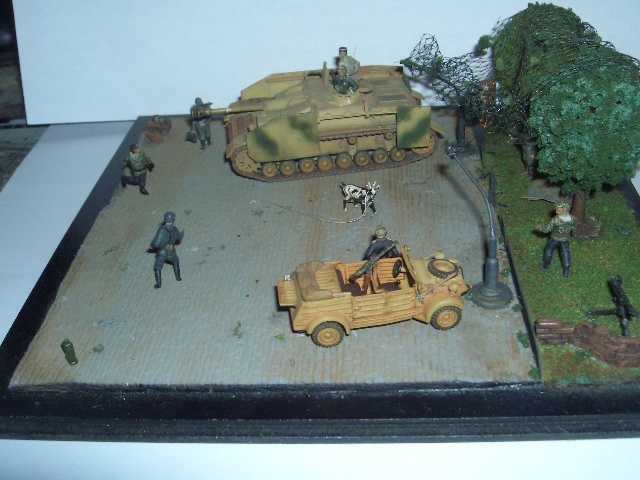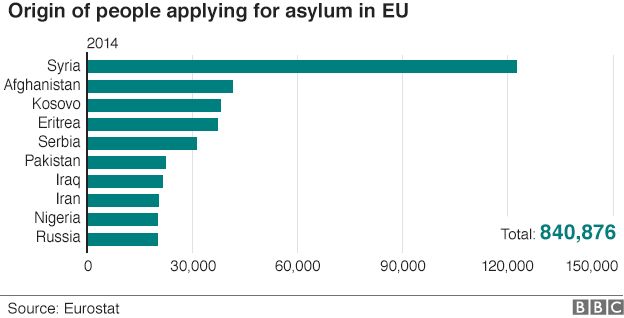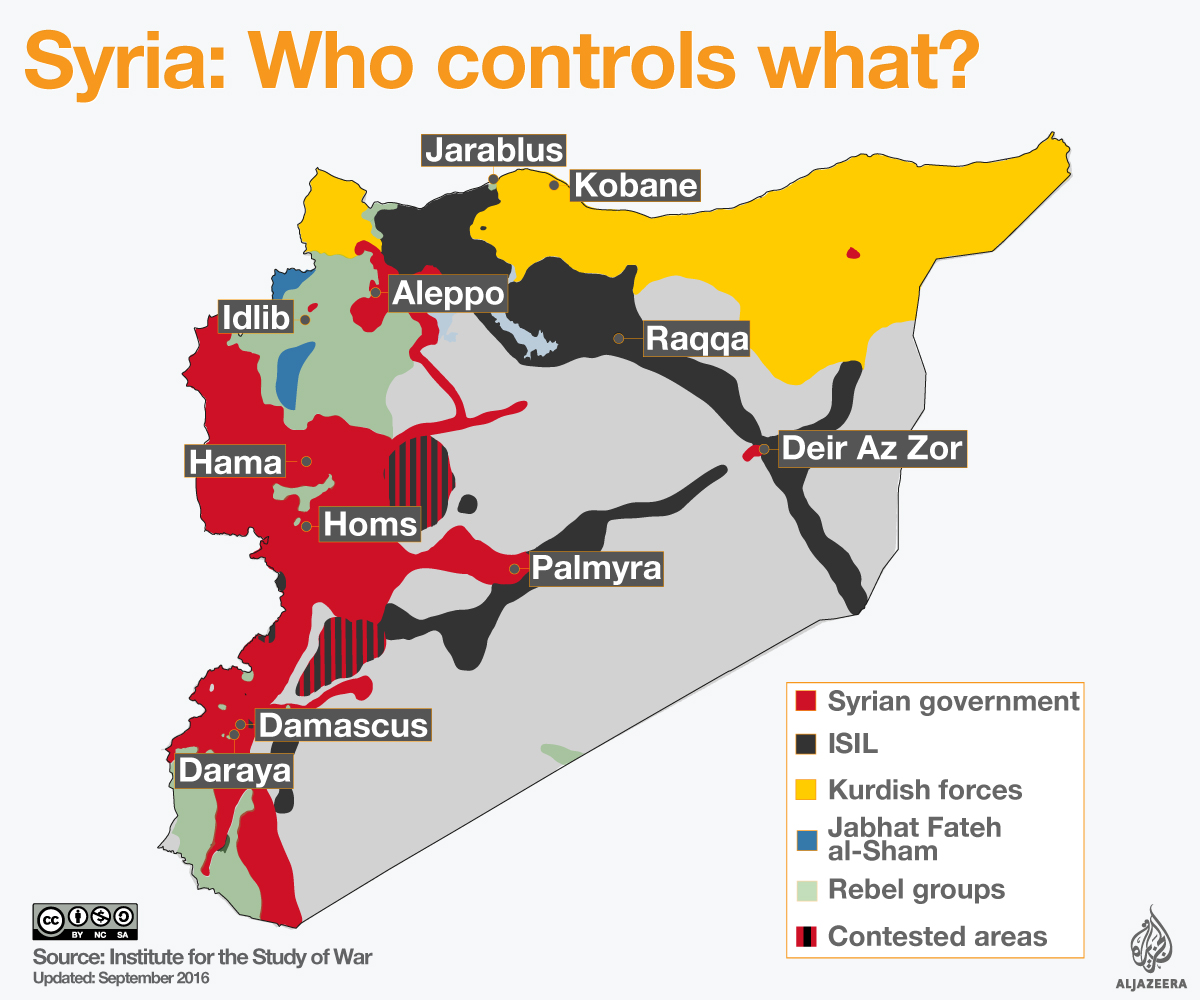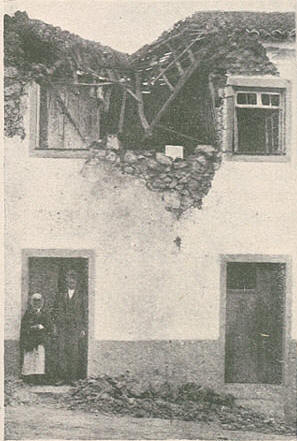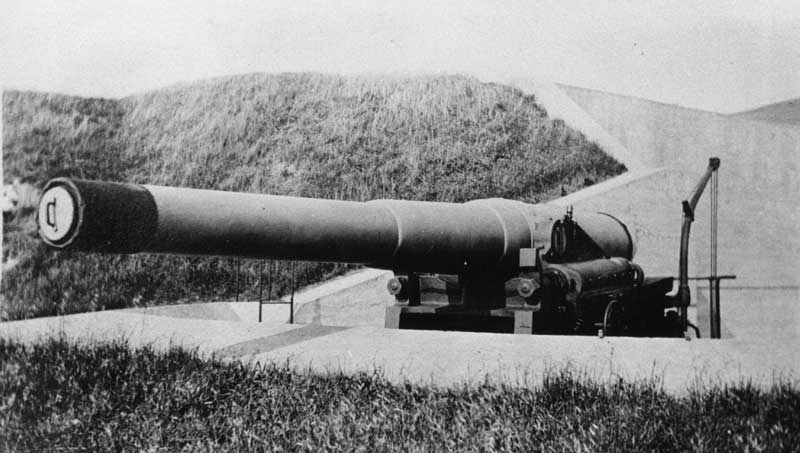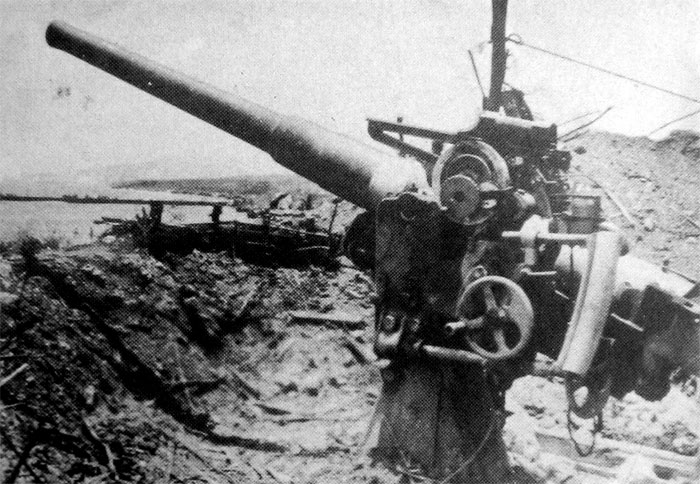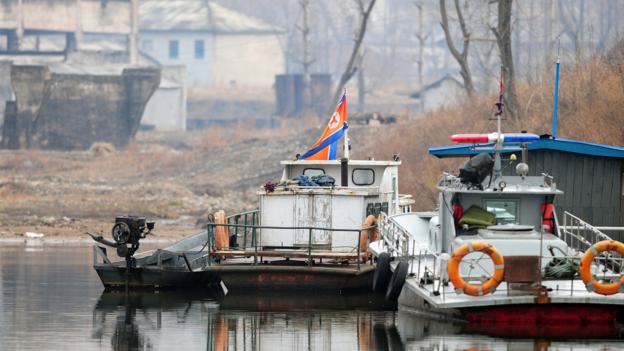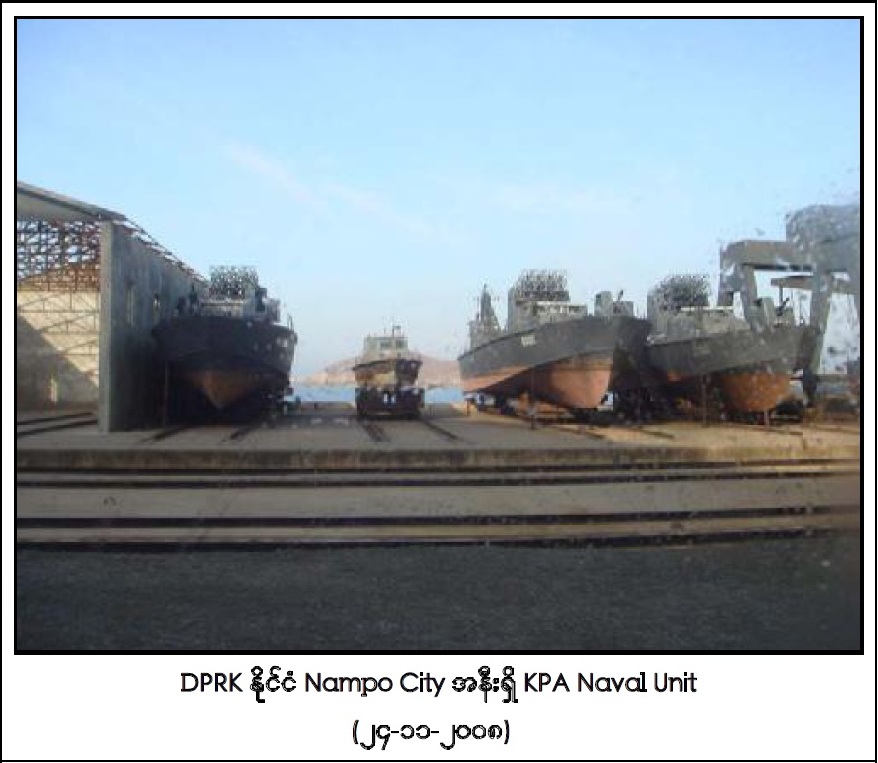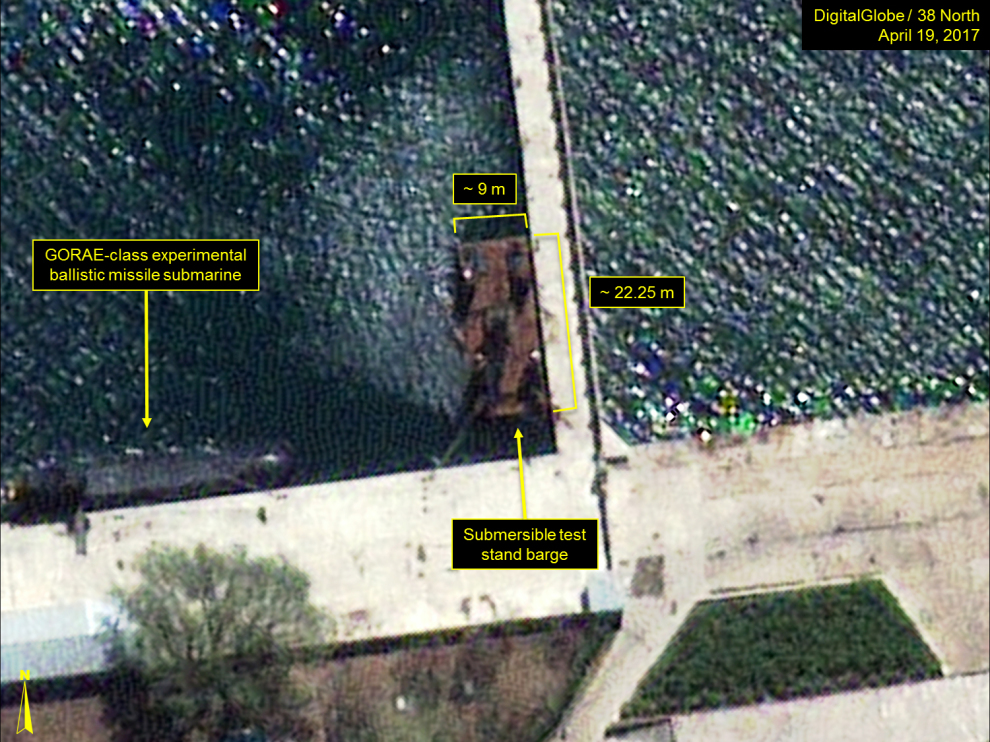What a like most in modeling is freedom. Today i make models when i want and with no pressure from anything. It is me and the models. Probably in the future the only site were i will keep my models on display will be this (and my home of course). Because it's me and my models, were there's no crapp, no shit stuff or things that i don´t like and i don't agree in a thing that is only for me a hobby (i make money for me and my family live reasonably, write and model are only for spent time). And i´m fine with this, and my readers are fine with this to, and the others have all the modeling world to their stuff and things. 20 000 views, how. Thanks to all. I promise that i will keep this bloog t'ill i can and the modeling it´s a bonus. Cheers.
Pesquisar neste blogue
terça-feira, 8 de novembro de 2016
sábado, 24 de setembro de 2016
It is a Migrant Crisis. Not refugees... (part 1)
Yes it is. By 2013, 2014 and middle 2015 the EU asylum applicants were also from nations without war like Russia, Servia, Kosovo and Iran. It is true that most people came from conflicts zones, like Syria, Afeghanistan, Somália, Eritreia and Iraq but more than half are from areas were the populations leaves because they want a better live. If we see close to Eurostat data the problems begin in 2013 not 2015, just in time for Syrian war escalation and the start of the second Libyan Civil War. Of course the problems in Africa and Iraq situation are influencing the migrant number, that was in 2013 and 2014, more than 600 000 and 860 000 individuals, but this conflits started in the beginning of the century or until in the last decades of XX century. The refugees from this countries came from their nations but the boarding site is Lybia and Siria (after the civil war star). So, Midia and western politicians are wrong, because we have today is also a migrant crisis, not only refugees.
Introduction:
The western countries were always a migrant and refugees destination. Also a source for hand of labour for example to United States, Europe see for example in the 60s migrations movements in the own continent from Portugal to France. With the end of colonization there was a significant movement between Africa and Europe, when Europeans settlers retourned to ther original nations (or from their ancestors). African natives with european citizenship move also to "metropolis" and the clash was enevitable since majority was not prepared for duplication of the numbers in the cities. The main problem was the number not the race or other items, but of course ideology and racism were present. Religion was not, since most of the individuals were cristians and the islamic were only a few. Tolerance and acculturation made the rest. Politicians were enough competent to give primacy to acomodation and food suply than to minor clashes in between this or that group and police and justice made the rest. Extradite was used if required but with no Human Rights actvistis and Mídia roof present the authorities made their joob, most of the time good. Was simple: who was entitled to stay was most welcome to country and who was not leave to their original nation. Yes, asylium don't work very well for example in cases of persecution and people were kill after send back, but the today solution of give asylium to most everybody was not a option, mainly to social problems but of course the danger of a cultural and religion clash was also considered in that early times.
Control of migrants and refugees was the major key in the 80s and 90s to western countries. The balance was the right formula but several events change the world dramatically, with the end of Could War at the top. Without the "two blocks", money and incompetence quickly ruled the world and the "actors" made their movements to rich and powerfull without care with the results (althoug some warning by scholars quickly derided and called "idiots" and masters of disgrace by the "experts"). EU made ther "border end" (one of major desasters, like also single currency, etc), USA liberalized all and nations like Australia and Japan they were by the middle. The old communist block was dead and Russia with one or two ancient republics had their problems. United Nations were soon outdated with Balkans, foreign affairs was a joke and when terrorrism made ther way in September 11s, was a surprise and i don't now why becouse the 90s were a chaotic decade. Soon a injuried USA attacked Afghanistan but the major problem was when they attack Iraq in 2003 (after Lajes reunion, remember?). Since then to Arab Spring it was a glance. Consequences? does not matter. Oil first, arms sales second and ended with "the nasty dictators" part of them old allies from "cold war times" were the tree major tasks of western world. If Syria was a confirmation, Libya was a surprise with all the World (UN and old soviet block include), to be incompetent in their agreement. After all business is Global.
Development:
Surprisingly no one near the politician and military predicted what it came following, what tell us the level of incompetence and collusion near the decision center. Of course there are exeptions, but they were silent (by others or buy themselves to keep the joob), ignored, apart or derided, from the main chain of control to the single blog analyst in Bermudas or Bahamas. After all other interests lifted up (ahh, the money, oil and influence). But there's a surprise: Ukraine. Perhaps was a collateral damage and Germany and UE only demand another marketplace to sell is products when they give a hope to their people in a full democratic nation with all the support from ocident. Again the real problem was very different what Merkle, Cameron and company expected: The crowds that Kurt Lewin explain in their books in a magnificient way guive to the "local vultures" and extremist groups who only want power made the rest and "guided the masses" in the streets. President Putin started to get nervous and the rest all the world nows. Probably the Russians in asylium apply in UE have some to do with the actual situation.
Well the "bad job" is done, and today the only sense to talk about the past is to prevent again in future. But this present problem if whe focus only in present, is not easy to talk and more difficult is to find a sollution in this "mad world". For example, everybody know war in Syria and that the bigger number of refugees is from this nation (it is normal that people who dont want to or can't fight run away from there). But what about Libya, Iraq and Afghanistan? What happen's there? And how people from Eritreia or Pakistan get to Syria? How they came? Who give them support? Why they are not detected by UAV, satellites or spy planes? This is about money and organized crime? About islam and an invasion like in the 7th century? Even in Syria we have to ask: How the hell migrants can travel in a country in war and were and how they get on the boat? Is the "Migrant net" a way to finance the war? Who is helping abroad? And why som politicians said "came all to our nation? That are all things that we will talk in the second part of this article, because is important to understand what is happening.
Well the "bad job" is done, and today the only sense to talk about the past is to prevent again in future. But this present problem if whe focus only in present, is not easy to talk and more difficult is to find a sollution in this "mad world". For example, everybody know war in Syria and that the bigger number of refugees is from this nation (it is normal that people who dont want to or can't fight run away from there). But what about Libya, Iraq and Afghanistan? What happen's there? And how people from Eritreia or Pakistan get to Syria? How they came? Who give them support? Why they are not detected by UAV, satellites or spy planes? This is about money and organized crime? About islam and an invasion like in the 7th century? Even in Syria we have to ask: How the hell migrants can travel in a country in war and were and how they get on the boat? Is the "Migrant net" a way to finance the war? Who is helping abroad? And why som politicians said "came all to our nation? That are all things that we will talk in the second part of this article, because is important to understand what is happening.
 |
Fig. 7 - The Migrations routes that finish in the Mediterranean at 2015. Has we see from five points to acess to the see, only two came from Syria. If it is true most of them came from conflit areas, it is a "mistery" how cities like Teeran in Asia or Tunis in Africa are part of this routes. Lybia after Syria is the main door to Mediterranean. Another "funny thing" is that we know the routes and they are long, but nothing is done except in the see. What are the reasons for that?
http://www.iom.int/ |
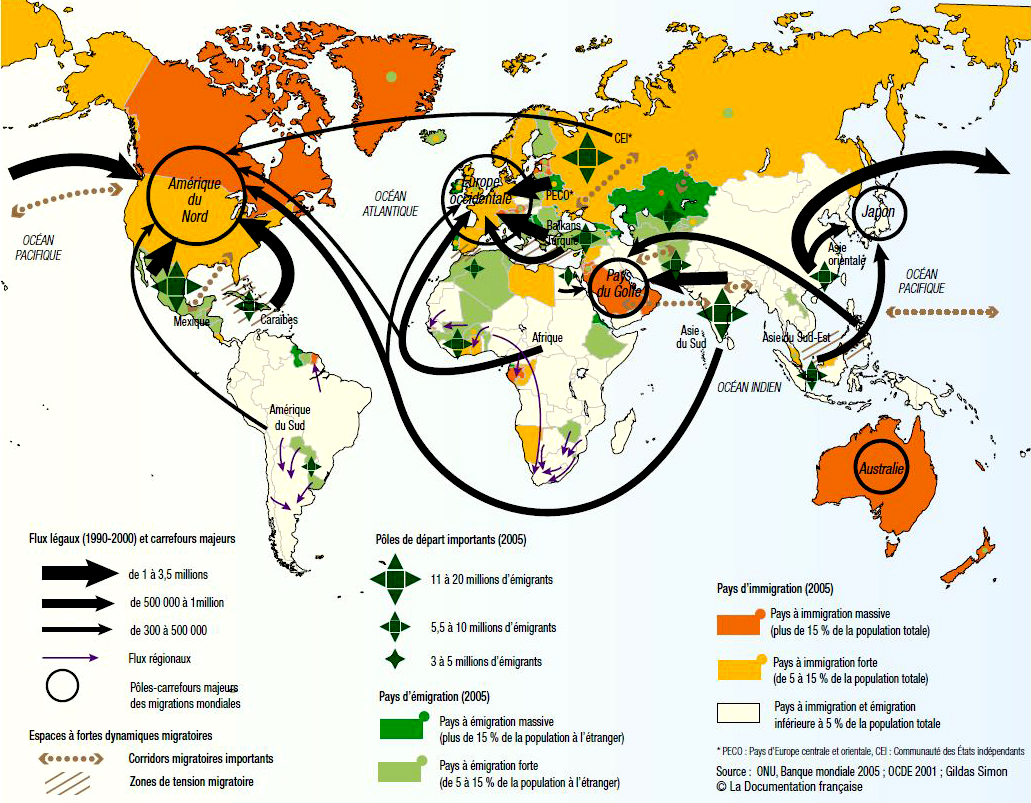 |
Fig.8 - Principal Migrations Routes in 2015. Not much change in Europe entrance, except the numbers. Again the information is all there why nobody have done much thing. Worse, the wars in Iraq, Lybia an Syria, make millions of refugees, who of course, they were added to millions of migrants who seek a better live.
|
quinta-feira, 25 de agosto de 2016
The Artillery Battery that never was... Milregos Battery
The Milregos battery started to build at same time that Casalinho battery (with an article in this blog), in 1916, as a complement to this last one (probably like in the 40s with 7st and 8st battery from the RAC), with one of them to be used at close range (we supposed Milregos) and the other at long range (Casalinho had 280mm guns). In 1919 and with the end of Fist World War, construction of both stopped. Only in August 29st, 1929 Casalinho was completed. With only one magazine house build and the acess road Milregos never see the day light. Casalinho quenched only it occurrued in the 60s, when 7st and 8st Battery were in full service, build not much far from the original first XX century Sado River Battery (8st is only 600 meters from Casalinho and probably about 3 or 4 Km from Milregos, but about last than 1 km from Outão fort, a much older artillery position). So we can't only speculate how would Milregos battery be (at least without a much bigger investigation, involving the Army files and much longer available time).
When Germany declared war to Portugal in 1916, coastal defence were made with mobile guns from the army in association with navy ship units and others from aviation. The main problem were german submarines that in some occasions used their guns to bombard main land (even Lisbon was a victim of this attacks with destruction and a mortal civillian). The need for a costal defence, in the main porst of all the nation, compounded by priority of the intense naval traffic in the vew of the cost and the need to protect, was assumed by Portuguese Governement and the Battery of Casalinho and Milregos was part of the sollution.
The objective was the protection of Setúbal bay and port, but like most of the portuguese military constructions money and labour problems made that only Casalinho was build and operational in 1929 and Milregos had only one small fraction build, after some interruptions. That we now, Portugal never had guns for this position especially buy. Maybe stock guns were the sollution but this is only speculation.
Since Milregos battery was never completed and we don't have access to army files from here (maybe in a near future), we only can make a fiction exercise about how would be and wich type os guns would be used. When RAC completed the 7st and 8st battery after WWII near Setúbal in simillar positions, one was a longe range function (Outão with british 152 mm guns) and the other close range (Albarquel with 150 mm german guns). So, it is possible that Milregos was planned was a short range gun position since Casalinho Battery had 280mm guns with a range of about 50km.
The guns are also a speculation exercise since guns in Portugal for this type of army facilities were various calibres and from army and naval provenance. Half buried or using vegetation and camuflage net the position woud be very difficult to see from a ship some kilometers in the river imput but the low geografic location and the ship aproach will make impossible a long distance fire. It is a mystery were the fire control and observation post would be placed in Milregos Battery but Outão fort was in a way of speaking the best location.
Another problem that was found in the construction of Casalinho and Milregos Battery had to do with expropriation of land in Comenda Farm, since the two areas were property of the noble Armand Roger Ernest Marie Joseph. The final business was only made in 1929 with the heirds of the cond Armad, but all the process biggins in 1919. Probably the price of Casalinho, the slow expropriation process and the geographic positions that become the artillery fire efficiency reduced (only the area between Outão and Albarquel was easily coverin, specially in the Troia peninsula direction), resulted that Milregos Battery was never completed. The chronic lack of money and the traditional neutrality that Portugal assumed especially by the internal problems and the need to secure the empire, translated into a come back of costal artillery in Setúbal area only when WWII biggin. In that time and becouse the planned Battery by all the country lead to some years of hard construction labour, hundreads of movel doble guns positions (AA and surface shoot) were spred in all the Portugal territory, since Europe to Ásia. (http://mindelosempre.blogspot.pt/2012_08_01_archive.html)
The guns are also a speculation exercise since guns in Portugal for this type of army facilities were various calibres and from army and naval provenance. Half buried or using vegetation and camuflage net the position woud be very difficult to see from a ship some kilometers in the river imput but the low geografic location and the ship aproach will make impossible a long distance fire. It is a mystery were the fire control and observation post would be placed in Milregos Battery but Outão fort was in a way of speaking the best location.
 |
| Fig. 3 - Figueirinha Beach and the narrow channel to Setúbal Port. Outão and Milregos are near a the distance range to a ship is this channel is less than a one Km. |
 |
| Fig. 4 - A British Sunderland in Troia in II World War time. Even being neutral Portugal had to deal with hundreads of ships and planes in the territory between 1939 and 1945. |
 |
| Fig.5 - "Ribeira da Ajuda" in Comenda Farm, about 5 km from Setúbal. Is right that Milregos Battery was started to build in the left margin but the place is almoust 1 km from that small river. |
 |
| Fig.6 - A portuguese shelter with a 75mm gun in France in WWI. Before fixed coastal artillery positions the guns used by the army in portuguese coast were mobil. |
 |
| Fig. 7 - As far we know this is was the correct location of Milregos battery. Today is a camping park. |
 |
| Fig.12 - Battery Maxwell Keys in Philippines in the 30s. Another possibility for Milregos, though Portugal used German and British models. |
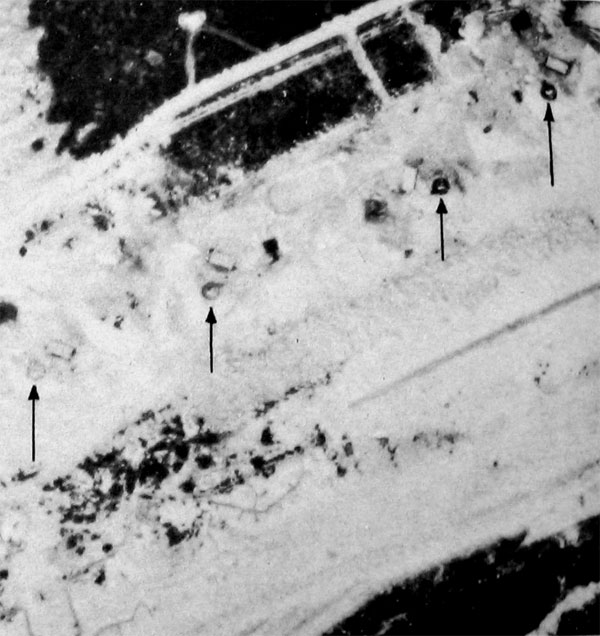 |
| Fig. 14 - Gun inplacement in Wake Island with four 120mm artillery. In Portugal Coastal Artillery positions had in most cases 3 or 4 guns. |
http://www.allworldwars.com/Photo-Interpreters-Guide-to-Japanese-Military-Installations-Part-III.html
https://pt.wikipedia.org/wiki/Bateria_de_Costa_da_Espalamaca
http://www.areamilitar.net/directorio/NAV.aspx?NN=6
http://www.operacional.pt/os-canhoes-da-castanheira-em-ponta-delgada%E2%80%A6/
http://fortalezas.org/?ct=fortaleza&id_fortaleza=1361&muda_idioma=PT
 |
| Fig.15 - Guns to Coastal Artillery sometimes came from ships and Portugal was no exeption. The guns to Espalamaca Battery was from Battleship Almirante Reis who used from 203 mm to 47 mm caliber. |
https://pt.wikipedia.org/wiki/Bateria_de_Costa_da_Espalamaca
| Fig. 16 - A gun location from Espalamaca Battery. All the costal artellery positions in Portugal were like this. |
http://www.areamilitar.net/directorio/NAV.aspx?NN=6
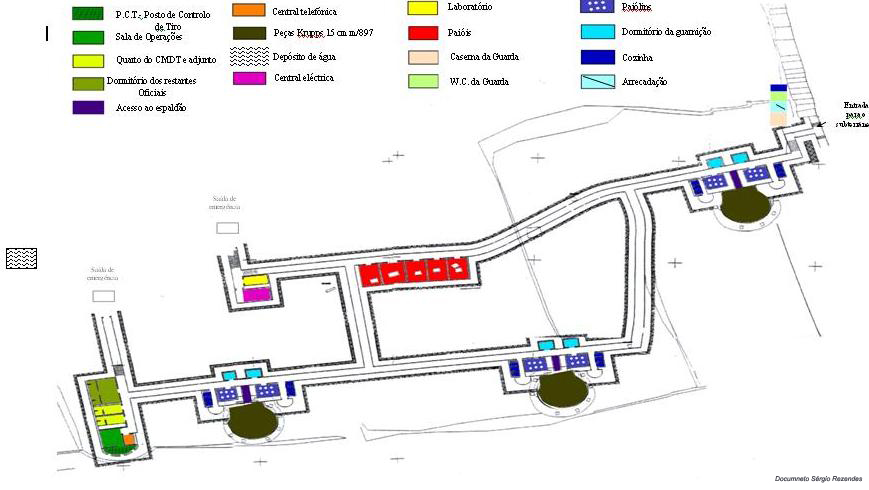 |
| Fig. 17 - Castanheira Battery in S, Miguel, Azores. We can see that most of the military position is underground. |
http://www.operacional.pt/os-canhoes-da-castanheira-em-ponta-delgada%E2%80%A6/
http://fortalezas.org/?ct=fortaleza&id_fortaleza=1361&muda_idioma=PT
sábado, 23 de abril de 2016
North Korea Navy: The most weak force in the nation
North Korea is one of the most closed nations to the world. The news about this country are a few for a year, and most of them, about their Lider or Military Forces. And in number they are strong, but in technology and equipment quality? It make sense that President Obama see NK as one of the threats in Asia (the other in China, one of the main allies of the Koreans)? And the Nuclear weapons? His there a military danger to Japan or South Korea? Let´s take a look, starting by the most week military force of the nation: The NK People's Navy.
First, if we see the organization of the Navy, (like in the up image), there´s two fleets with no possible comunication by sea in case of a war, Then, we look for a Navy with more than 700 ships but were most of them are small. Little torpedo and missile boats in the surface fleet and submarines (at least 26 diesel). Lots of landing craft but only a small number of support and mine warfare vessels. "Special Ships", used for infiltrations operations especially in South Korea there are no numbers. No aviation (there's a high possibility of North Korea Navy have some light aircraft http://cdn1.img.sputniknews.com/images/102100/83/1021008312.jpg or helicopters like the Mi4, the MI14 or Mi2 in use but no reable confirmation or a clear photo http://33.media.tumblr.com/d95c9157cefeaacdc01aee8d984738e2/tumblr_inline_mu5c5cCcBq1rznupj.png ) or marine corps (in some nations they are a part of the army and there's this picture were this PT76 is seen from an landing craft, probably from the Army https://s-media-cache-ak0.pinimg.com/236x/c0/cb/83/c0cb83c1bf0fee21b60ddae9b7bd22db.jpg ). Nevertheless is a Navy with 67 000 sailors (other sources say about 47 000 troops) and in a slow process of modernization.
 |
| Fig.2 - North Korea have the same number of pricipal Naval Bases in west and east (5) with fleet headquarters in Toejo Dong (a Sang o submarine in Toejo Dong Base http://www.diariodenautica.com/wp-content/uploads/2014/10/sango2.jpg) and Nampo (Small North Korean vessels in Nambo Base http://dailynk.com/efile/201103/DNKF00007412_1.jpg ) . |
Second. A costal navy like this has to have AEW or a Aquisition Target and Guidance System that we don´t see in North Korea (there's news about drones and satellites, but... http://www.space.com/images/i/000/016/482/original/north-korea-rocket-unha-3-satellite.jpg?interpolation=lanczos-none&downsize=660:*). If in the Korean War with convencional ships this type of navy was inoperative, in the XXI century only the submarines force are partially effective (like in the Cheonan Sinking https://en.wikipedia.org/wiki/ROKS_Cheonan_sinking ). If we look close for example to a Najin class light frigate (image above https://en.wikipedia.org/wiki/Najin-class_frigate) there's a small radar for each task with no range up to 77 km (no news about Datalink to receive data from other sources). When USA or South Korea use Cruise Missiles or the multi-purpose Harpoon with efective gps guidance, range of 124 km and with correction trajectory from helicopters or other small means, it is a nightmare for a navy like this (were is ECM or EW systems?) . Americans will allways fire first in more then 93 % of the times and with a chance of at least 60% of a direct hit.NKPN if have a 20% hit hipotese is a blast.
 |
| Fig. 3 - Nanjim Class http://i509.photobucket.com/albums/s340/warshipsresearch/FFGNajin.png |
 |
| Fig. 4 - The Onix Blog talks about Kh35E in KPN (Korean's People Navy). We only see the supose racks used to put the canisters. |
 |
| Fig. 6 - A Tral Class of light conventional Corvettes.
So, only a few of the North Korean Navy ships are capable to do ASW at some distance from the coast line. But with no medium naval SAM the air cover it is a mandatory. If we talk about the submarines of South Korea Navy (there's some sources indicate that two of midget submarines from Dolgorae class that had tree build specific for simulate North Korea pairs, are still active https://en.wikipedia.org/wiki/List_of_ships_of_the_Republic_of_Korea_Navy , but let's concentrate on 19 submarines from Chang Bogo and Son Wonil class https://en.wikipedia.org/wiki/List_of_active_Republic_of_Korea_Navy_ships ), capable of launch the UGM 84L Sub Harpoon with a range 124 km and able to destroy naval and land targets, we see the dificult task of the few and major ships for ASW. Nuclear USA submarines with cruise missiles like the Tomahawk have a range of 1300 km up to 2500 km. An almost impossible task for the North Korean Navy. A long range aviation for ASW and Maritime Patrol could help enough but there's no such type of plane in North Korea arsenal, for now. An 26 could do this type of mission but the few that North Korea have are for transport tasks with basic sensors ( https://en.wikipedia.org/wiki/Korean_People%27s_Army_Air_and_Anti-Air_Force ).
|
 |
| Fig. 7 - Torpedo boat 23 (a G5 class former soviet motor torpedo boat) claims that he sank USS Baltimore who never was in Korea. One example of North Korean propaganda https://en.wikipedia.org/wiki/USS_Baltimore_(CA-68) |
North Korea had long traditions in torpedo boats and small crafts. The upgrade for missile boats was a natural change, but only in half way. More than 217 against a minimum of 24 and possible about 100 today. Unexpected was the amount of hovercrafts and landing crafts in North Korean Navy: more than 100 LCVP /LCPA and 135 LCV. Hovercrafts are an expensive mean and are mechanic speaking, complex to operate. But they are very usefull, specially in Korean peninsula full of islands, some near the coast line but others at distance from the main land. With a fast LCVP/LCV one force could conquer one of South Korea island in minutes or hours, if near the famous 38 th parallel. (https://www.lib.utexas.edu/maps/middle_east_and_asia/korean_peninsula_rel_2011.jpg )
And we cannot forget that area have disputed territory in the sea, with only in this century four major incidents betwen the two Koreas ( http://s3.reutersmedia.net/resources/r/?m=02&d=20150821&t=2&i=1073533914&w=644&fh=&fw=&ll=&pl=&sq=&r=LYNXNPEB7K0N6 ).
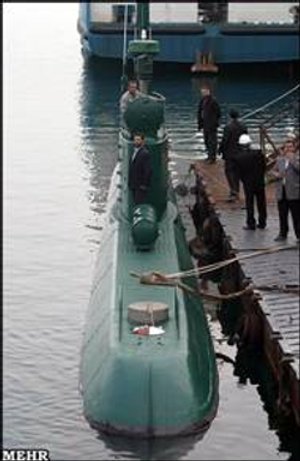 |
| Fig. 8 - A Yono class midget submarine. |
Analyzing more deep the fleet, mine warfare vessels and auxiliary ships are only 30 of each. Probably some of them are civil (no photos of military vessel's of this types were seen http://www.asianews.it/files/img/KOREA_(f)_0326_-_Navy.jpg and for example the list of civilian ships are not so big if we think that the country is isoleded from the rest of the world http://www.alphabetics.info/international/wp-content/uploads/2009/08/india-north-korea-ship.jpg). This means that the North Korean Navy have a very limited capacity to support long actions, in time and space, away from their bases and that poor logistics affect major naval movements. No big amphibious platforms or replenishment ships means that oil, equipment, munitions, etc, are a concern up the military in missions and that the troops movement and the heavy equipment with the air support are dependents from Air Force and Army logistic. Probably civil ships were call in major actions. Again, the Navy have difficulties in several actions, away from coast line and far from their waters. And not forget that are two fleets: west and east, with no comunication between them by sea.
 |
| Fig. 9 - P6 class ( http://weaponsystems.net/weaponsystem/GG02%20-%20P-6%20class.html ) |
But North Korean Navy have two probable "aces": First, infiltrations boats; Second: Submarines. A small craft or ship is dificult do detect by a radar or infra-red sensor, but a stealth boat is two times hard to see in a sensor or in visual contact (i'm not talking about stealth figth ships like 30 m PCF http://38north.org/wp-content/uploads/2014/04/Fig-10_Sat-Img-Stealth-Patrol-Boats-990x555.jpg or the 23 m PCF http://i2.cdn.turner.com/cnnnext/dam/assets/150209182427-tsr-dnt-todd-north-korea-new-missiles-00000000-large-169.jpg , but real stealth infiltrations ships like Type D improved SILC that in North Korea is seen with no guns or torpedos tubes in the hull http://media.farsnews.ir/Media/8501/ImageReports/8501170180/1_8501170180_L600.jpg). I belive that there's no stealth paint or materials, with the shape making them hard to see an detected, especially at night (pure stealth tecnology was only seen in the light corvette of the Nongo Class https://en.wikipedia.org/wiki/Nongo_class ).
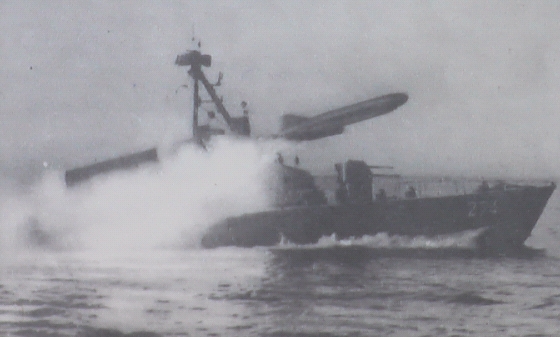 |
| Fig. 10 - A Komar class missile boat launch a SS-N-2 Styx |
Other like P. Nongo VSV ( http://www.globalsecurity.org/military/world/dprk/images/p-nongo-image01-s.jpg ) or the "Ghost Ship" ( https://www.youtube.com/watch?v=wssj5tclidE and http://www.stripes.com/news/north-korean-ghost-ships-found-off-japan-s-shore-present-a-grim-mystery-1.381883), looks more photoshop or speculation than reality. Neverthless The Thelegraph understand the main reason behind the VSV: Not combat but infiltration of saboteurs or agents in South Korea main land ( http://www.telegraph.co.uk/news/worldnews/asia/japan/11634933/North-Korea-deploys-new-generation-of-fast-warships.html ). And Type A, B, C (Sp10), I - Silc, I - Silc (Viet), Taendong B and C, are real. Seems inspired by the Cartels Cocaine Submarines ( http://www.combatreform.org/thunderballfromunderthesea.htm ), or the Ghost military watercraf (the first super cavitating ship http://www.combatreform.org/thunderballfromunderthesea.htm ), this infiltrations boats are easy to produced and complicated to detect. Several were sink or catch but how many escaped? http://www.boatdesign.net/forums/all-things-boats-and-boating/semi-sebmergible-boat-6975.html
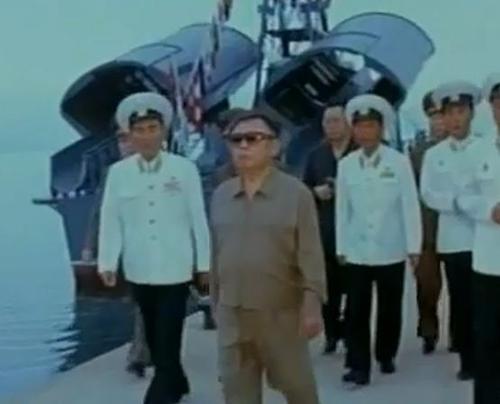 |
| Fig. 11 - Kim Jun Ill visit a Sohung (Komar class made in China) missile boat. See the containers for SS-N-2 Styx are behind the ex. North Korea leader. |
Armament in this ships are small arms. But Taedong B and C exported to Iran have torpedos and probably mines are also on board. If the low project and the difficulties to see at open eye are an assurance, with some stealth tecnology (North Korea is still in childhood of this technique), the problems to the South and USA wil be mutch more. And the use of a civil mother ship to infiltration or as a base to other crafts is a high possibility ( http://militaria.forum-xl.com/viewtopic.php?f=78&t=711 ). Not only for infiltration ships but also to drive operations with midget submarines like the one captured in 1979, and Sbs-2 Swimmer Delivery Vehicles. But if this underwater objects are a problem, other submarines in the North Korean arsenal are a real headache. And the nations have at least 70 of diferent types, from little Yugo Class ( https://www.stratfor.com/sites/default/files/main/images/north_korea_submarines_0.jpg ) to a much dangerous class ( http://www.popsci.com/north-korea-probably-launched-missile-submarine ). ROK take this infiltration treath for real and have an strategy to solve the problem ( http://fas.org/man/eprint/anti-sof.htm ). And real results are at sight in South Korea ( http://static.panoramio.com/photos/large/33034637.jpg ).
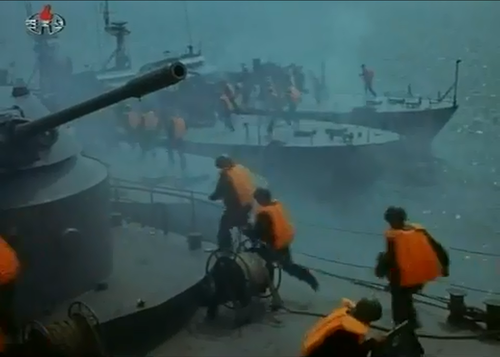 |
| Fig. 12 - Some sailors pass by a 85 mm gun from a Sariwon/Tral corvette or a Chongin Pb class (http://panther37.xtothezracing.com/earth/military/PB-Chongjin-Turret.jpg ) in a propaganda movie. Above two P6 torpedo or patrol boat http://33.media.tumblr.com/6e48a5dbae9001fd42ce21974f3f54c1/tumblr_inline_mu5akykOWJ1rznupj.png ). |
USA about North Korean Missiles submarines are to "confortable" with them. No danger for Usa but what about south Korea? ( http://www.cbsnews.com/news/north-korea-years-away-from-submarine-missiles-us-says/ ). After all, the North Korean submarines are old and the ones made in the nation to small, but there's images of a submarine that looks like an experiênce of missile launch by a submerged vehicle ( https://www.youtube.com/watch?v=ijOnQrOTw_E ). A second photo from a video was seen when Kim Jung Un visited a new submarine ( http://www.88p4.com/2015/06/09/the-new-north-korean-ballistic-missile-submarine-zhenrong-exposure-figure-128342.html ). Third, the launch of what it seems a fake missile launch ( http://www.koogle.tv/media/news/north-korean-submarine-missile-launch-may-spark-fears-of-arms-race/ ), but that caught attention from South Korea and Japan. Why? Becouse they now how easy is to make a convencional submarine with 3 or 4 tubes in the sail like convencional diesel-electric Golf / Hotel Soviet submarines era ( http://www.hazegray.org/features/russia/boomer.htm ). It seams that NK have at least one Simpo Class with one/two launch Tubes ( http://military.no-ip.info/NK_Sinpo/korea_SSB.jpg ). But nuclear missiles in North Korea are large an heavy, so is very dificuld to place one in a submarine (http://www.kcci.com/image/view/-/37863208/medRes/3/-/maxh/460/maxw/620/-/1u93rxz/-/North-Korea-Missile-launch-png.jpg ).
 |
| Fig. 13 - Type 033 (Romeu Class) of North Korea seen on top of photo near Ming class Submarines, in a Chinese parade. This submarines were send to North Korea by kit and assemble in the country |
More. The North Korean SLBN looks like an R27 Zib (and the program is advance from the old KN 11 http://www.kcci.com/image/view/-/37863208/medRes/3/-/maxh/460/maxw/620/-/1u93rxz/-/North-Korea-Missile-launch-png.jpg ). Fortunately the warheads are weak and the missiles very experimental with South Korea and Japan recovered some of them from the sea ( http://i.dailymail.co.uk/i/pix/2013/04/15/article-2309532-194FF6BB000005DC-602_634x495.jpg ). No news about the suposed missile launch by a submarine. Some tv an news support the idea that one or two launch fail from the Simpo class but there's no certain about that. No evidence of MIRV or multi-warhead on North Korean missiles. Even so, with a Space Program ( https://en.wikipedia.org/wiki/Korean_Committee_of_Space_Technology ), and some sucessful lauch were made with the Kwangmyongsong 3 united- 3 and Kwangmyongsong 4 (observations satellite ?) in 2012 and 2016, the prospects other purposes like orientation of nuclear missiles or get targets for cruise missiles are hypotheses.
"Were is smoke there's fire", like we say in Portugal and North Korea has made some progress about nuclear balistic missiles from submarines and satellites in space tho give them orientation and targets. Probably a lauch in future from a submarine will be in surface becouse it is much easy, but we don't know what technology North Korea have in this area. One assurance: This nation have great difficulties to build large submarines, and it's needed a modern and big submarine to be a threat to USA or Japan so far away. The problem is South Korea even by the side (South Korea and USA have large ASW and anti-missile systems, but a submarine and a nuclear missile always have some danger, even being old and outdated).
"Were is smoke there's fire", like we say in Portugal and North Korea has made some progress about nuclear balistic missiles from submarines and satellites in space tho give them orientation and targets. Probably a lauch in future from a submarine will be in surface becouse it is much easy, but we don't know what technology North Korea have in this area. One assurance: This nation have great difficulties to build large submarines, and it's needed a modern and big submarine to be a threat to USA or Japan so far away. The problem is South Korea even by the side (South Korea and USA have large ASW and anti-missile systems, but a submarine and a nuclear missile always have some danger, even being old and outdated).
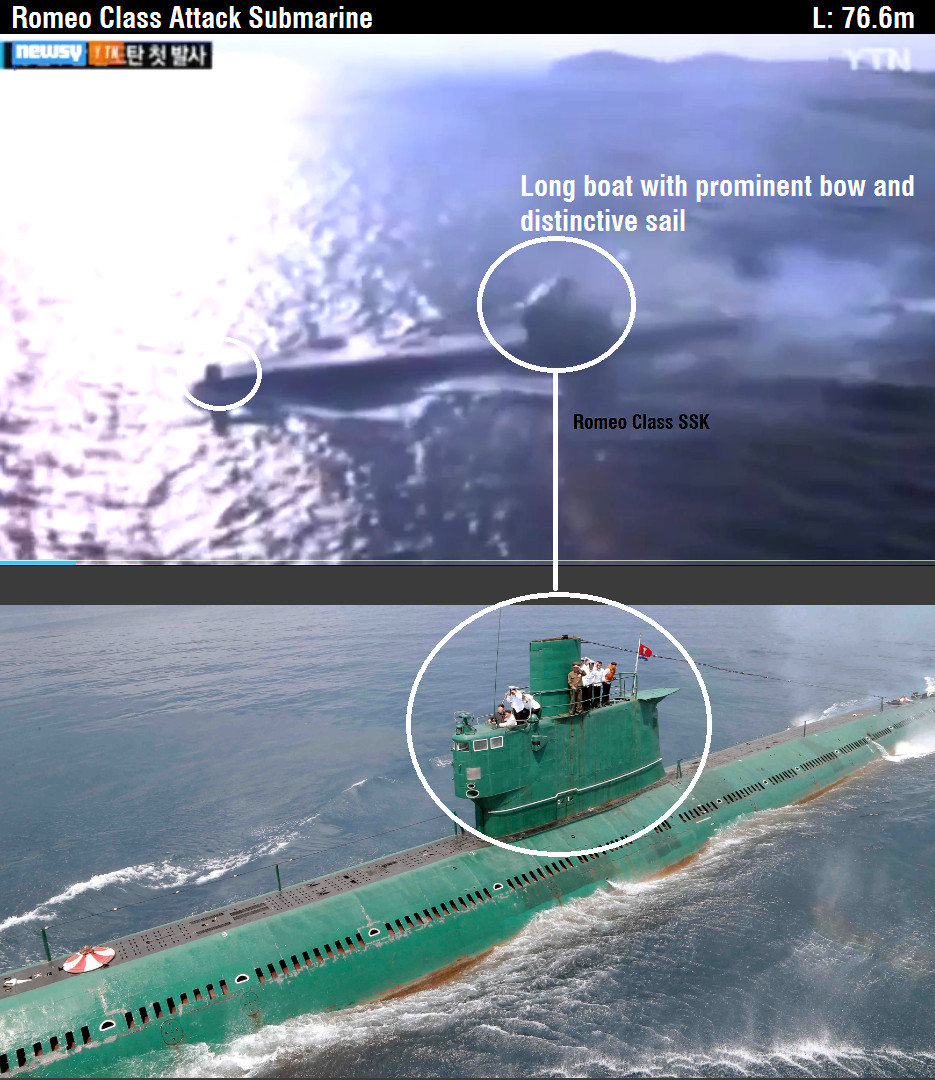 |
| Fig. 14 - A Romeo class ssk. The Nort Korean "Slbn" seams influendes by Yugoslavia submarines than Russiam or Chinese http://freebeacon.com/wp-content/uploads/2014/11/A-new-submarine-docked-at-a-North-Korean-factory-is-a-missile-firing-submarine.png |
But let's talk about convencional submarines: North Korea have between 51 and 72 (or 77 if some of the Yugo classe are still in service https://en.wikipedia.org/wiki/Yugo-class_submarine ). Only 22 of the Romeu Class and the Simpo Class (one in construction ?) are true submarines. The rest are coastal or midget submarines (around 50), and this seems the current strategy of North Korean Navy, since Romeu Class are being phase out in favour of Sange -o- class of coastal submarines. Only exeption is Simpo Class with some sources saying that is a diesel experimental SSBN (http://foxtrotalpha.jalopnik.com/north-korea-tests-sub-launched-ballistic-missile-capabi-1703424510). Although the type seems to have potential to be also a class of conventional diesel-electric submarines it is unclear by the known photos if there's sail tubes for one or two missiles or only torpedo tubes (https://en.wikipedia.org/wiki/Sinpo-class_submarine). Analyzing the size and form of the submarine it seems highly influenced by Heroj and Sava yugoslav submarines (Golf class with missiles tubes in the sail are much higher (https://en.wikipedia.org/wiki/Golf-class_submarine ).
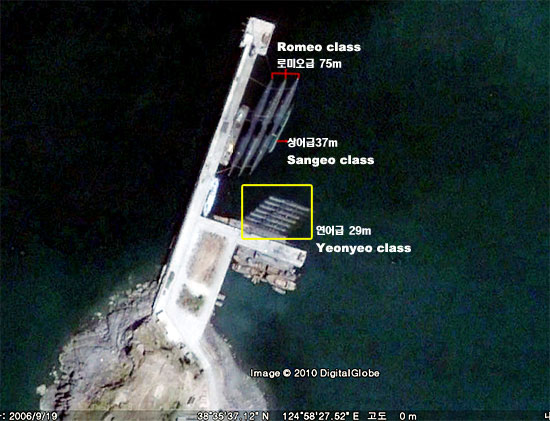 |
| Fig. 15- Submarines of North Korean Navy in Nampo. Sang o and Yeonyeo class are midget submarines, used for atack and infiltrations missions. |
The small submarines doesn´t have a great range, are limited in weapons and mission time but near the coast their detection is very difficult. Teams of saboteurs and spies can be dropped easily in South Korea and the prove is that some of them were captured by ROAK forces. Ideal for a brown water navy and that operates within 50 km from exclusion zone, with 46 000 men and 711 ships. True that a vessel from the west fleet could'n visit the east one, but the danger of ROAKS Cheonang be sinking by a midget submarine from Yono or Sang O class puts pression in south navy were the fail in detection could lead to a desaster (there's a possibility of have been 2 submarines and a support ship, in a sea were Us Navy and South Korean Navy were in ASW exercices, to sink Cheonang corvette https://en.wikipedia.org/wiki/ROKS_Cheonan_sinking ).
Size also means that in some rivers, bays and gulfs, these little submarines could ambush bigger enemies units, with torpedos, mines or saboteus with explosive charges. Probably the substitution of the Romeo Class by Sang -O- it's a matter of tactics, were ocean submarines are deprecated by coastal models, because are more easy to build and better to use in a brown water navy system by North Korea.
 |
| Fig. 16 - Torpedo boat and missile craft. About 234 of 9 torpedo boats and missile types. |
Conclusion
The Korean People's Navy is the branch of the People Army, Armed Forces of North Korea, and probably the most limited of the North Korean forces, with a defensive role especially of their surface fleet. Ofensive role is a task for submarines and clandestine missions are one of their main task, with Type C infiltration boats or wooden fishing vessels (specially caught in Japan http://www.maritime-executive.com/media/images/ghost%20boat.jpg ), or midget submarines like the Song O class.
It is made to support the Army or make fast operations at maximum range o 50 km from the cost line, with the roof of land SAM, airforce, coastal artillery, EW and Jamming systems
Nambo is clearly the main base North Korean Fleet, taking into account the number of exercices, fleet ships and facilites ( http://www.globalsecurity.org/military/world/dprk/images/p-ses-b-image01.jpg ). East sea fleet have more 170 ships than west, and the main confrontations are all in the East, with only the Battle of Amami-Oshima taking place in the west ( and between North Korea and Japan https://en.wikipedia.org/wiki/Battle_of_Amami-%C5%8Cshima ).
 |
| Fig.17 - With a Navy of close Range, North Korea operates in range of land based SAM, SSM and Coastal Artillary. |
Even the infiltraded missions are made with midget submarines and special infiltration crafts in the yellow sea but with Japan are North Korea only send "ghost ships", normally fishing boats with saboteurs or a spy crue. Large missiles are often fired against Japan from land but all of them fall in the sea and collected by Japanese Navy (http://media.therakyatpost.com/wp-content/uploads/2016/02/000_Hkg10254318-940x470.jpg ).
East or the yellow sea is much better for a "brown water navy". With lots of islands and a coast full of good places for wide a little torpedo, missile boat or submarine, who can wait by the enemy and fire with some sucess. West is more ocean and it needs a type of more large ship, that North Korea doesn't have and can't produce with a very limitied industrie and with many problems in energy production and fuel resources (NKPN have about 10 large frigates, corvettes and patrol boats. Only tree are not from the 60s and made mostrly in the nation).
Main operations arena are east and against South Korea, with several battles with variable result, and an acurate search give us the assurance: South Korea navy is a lot more powerfull than the North Korean on. Why? Will see above.
East or the yellow sea is much better for a "brown water navy". With lots of islands and a coast full of good places for wide a little torpedo, missile boat or submarine, who can wait by the enemy and fire with some sucess. West is more ocean and it needs a type of more large ship, that North Korea doesn't have and can't produce with a very limitied industrie and with many problems in energy production and fuel resources (NKPN have about 10 large frigates, corvettes and patrol boats. Only tree are not from the 60s and made mostrly in the nation).
Main operations arena are east and against South Korea, with several battles with variable result, and an acurate search give us the assurance: South Korea navy is a lot more powerfull than the North Korean on. Why? Will see above.
.jpg) |
| Fig.18 - Comparison between some Asian fleet. China and North Korea have mutch more ships but the other naval nations have much more modern ships.
The losses of a Chamsury Class 357 patrol boat ( http://media.gettyimages.com/photos/the-south-korean-navy-raises-a-bulletridden-naval-patrol-boat-august-picture-id1346339 ) and RoK Cheonan 772 corvette, in about eight clashes between North and South Korea (https://static-secure.guim.co.uk/sys-images/Guardian/Pix/pictures/2015/5/8/1431067227887/03cc0296-9ebf-4764-ac56-f22aedac37bb-2060x1236.jpeg ), were exeptions. NKPN lost 2 submarines, 2 infiltration boats and 1 torpedo boat, with much more dead and wondead sailors that South Korean navy. With equal firepower, sensors and much more modern guns, even in a close support confrontation, they make the south win. In a BVR confrontation, a modern tracking and aquisition radar, fire - control, datalink and optical sensores, will make devastating fire over enemy ships. For example, an SSM attack with the Harpoon (NKPN have for example C802 but there's no modern radar for detection an guidance), at 100 km by a South ship will had the acquisition and tracking by a airborne radar and a final way correction by a sensor from an helicopter all with the help of datalink. North doesn't now what is that becouse they have a navy to a close range from the coast, were by North Korea tactics small torpedo and missile boats, cant operate without range umbrella from SAM, electronic war and aircraft roof. Small and low are dificult to detect but not impossible, by modern sensors and satellites (the North only have two of observation in more than five launch attemps), that North Korea doesn't have. Asw is another problem, basically becouse depth charges and rockets are a close range weapons when a UAM Harpoon have a 120km range (sonars are old and fixed). That lives the submarine was the only NKPN ofensive weapon (and yet...).
|
 |
| Fig.19 - Rok Cheonan corvette sinking, probably by a mine or torpedo from a North Korean submarine ( https://willyloman.files.wordpress.com/2010/05/official-version.jpg) |
A force of midget submarines make sense in Persian Golf, Baltic or Caspian Sea. In the Pacific they have limited use, like the japonese proved in WWII ( http://ww2db.com/other.php?other_id=34). Small, limited range, hard to guide in the ocean, they need a base ship (North Korea probably use civil ships becouse there's no military ones) and they are no hard to sink. The problem is that the Nort Korean alone only can produce in series submarines above 370 tons (Romeu were assembly nin country with pieces from China and Simpo is just one). They use for infiltration saboteurs and military personal, to atack near the cost of main land or an island (Roak Cheonan was sunk near Baengnyeong island by a suppose Sango submarine), or drop mines. But in the Ocean, are not effective and in the Pacific only a much bigger submarine is effective. Whiskey are no longer in use (of four maybe there's one). Romeo are outdated and the only real modern submarine is the Simpo class, made from inspiration of yugoslavian contemporary). Simpo seams a really good class, with torpedos and two missile tubes in the sail (the only balistic missile test from a submarine was made from this class ? http://fijione.tv/wp-content/uploads/2015/05/South-korea.jpg ).
It will be the industrial capacity of North Korea of build powerfull nuclear warheads, Simpo submarines and a effective missile for a submarine, that will dictade if North Korean nuclear program is a treath to korean peninsula and neighbors like Japan. If so, is a danger for peace and to a nuclear Asian Southeast. If it fails, and nuclear missiles continue in earth and mobil ramps, only with multi-warheads, better sensors, data link and orientation systems, will make North Korea a threat to many nations beyond South Korea. And for now this last scenario is far away. US, China, Japan, etc, can reast (and pray for Simpo class fail or North Korean fail in a mass production of the type).
 |
| Fig.21 - A North Korean PT fires is main 85mm gun against South Korean Patrol boats in The second Battle of Yeonpyeong. One PKM and 6 sailors were lost but North Korea had 13 crewmenbers dead and 25 wounded. ( https://en.wikipedia.org/wiki/Second_Battle_of_Yeonpyeong ) |
http://koreadprk.tumblr.com/post/63083329771/kim-jong-un-documentary-succeeding-the-great-work
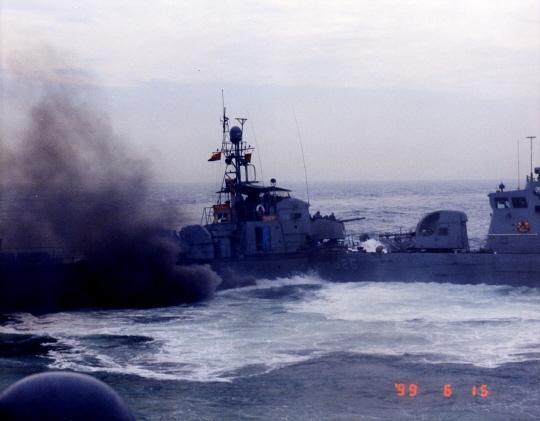 |
| Fig. 22 - First Battle of Yeonpyeong. Pt 381 is bumped by South Korean fast craft. At the fire of 25 mm from North Korean Guns the South Koreans retalied with 20mm, 40 mm and 76 mm weapons (https://en.wikipedia.org/wiki/First_Battle_of_Yeonpyeong ). |
 |
| Fig.23 - A torpedo boat from Shershen Class. North Korea have only 3 of this fine crafts in service. |
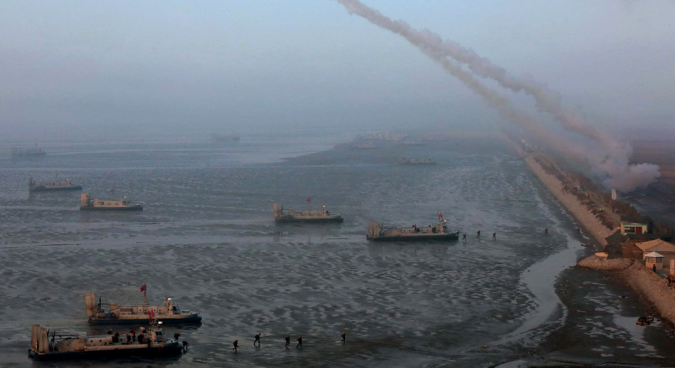 |
| Fig. 24- Naval exercices at Nambo Base (in this image a satellite image of 2015 exercices https://www.nknews.org/wp-content/uploads/2015/12/Oct_2015_naval_exercise_5.png and https://www.nknews.org/wp-content/uploads/2015/12/Oct_2015_naval_exercise_3.png ). |
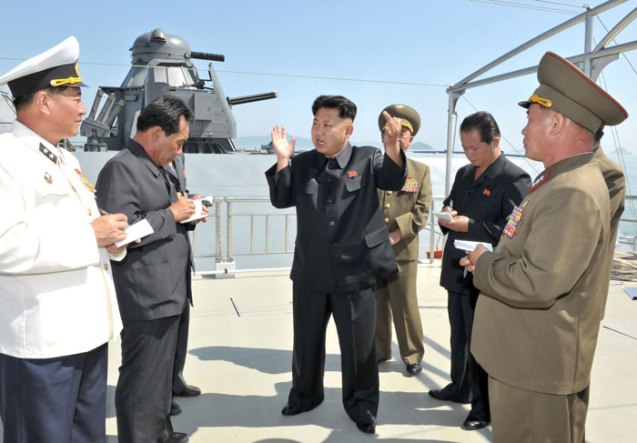 |
| Fig. 26 - Kim Jon Un on board of a Nango class light corvette. A 30 mm and a 57 mm gantling guns are seen at top of image ( http://farm8.static.flickr.com/7370/16413384929_6ae7bb973d.jpg ) |
Fig . 25 - A Osa I missile boat. Eight of twelve are still in service
http://www.globalsecurity.org/military/world/dprk/navy-base.htm
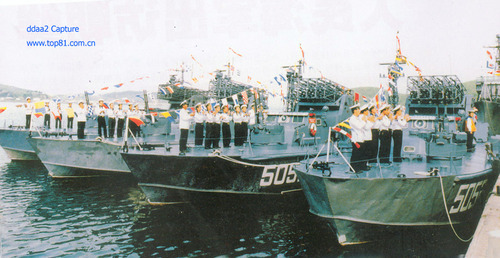 |
| Fig. 27 - A rare photo of Chaho class Rocket Boats.This type of units have a very limited use in a modern war. |
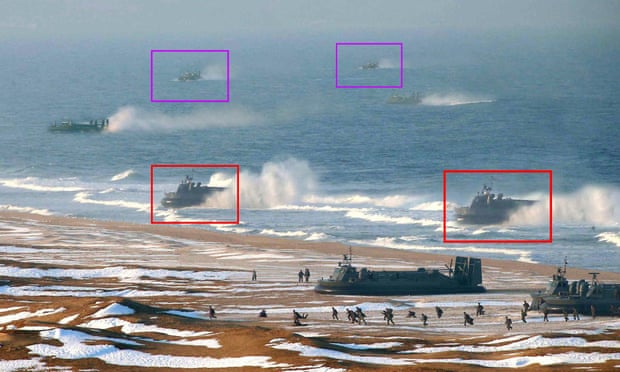 |
| Fig. 28 - A Photoshop Image (at least for The Guardian newspaper)? Eight Kongbang class assault ACV reach the beach in an amphibious exercice. (http://www.theguardian.com/world/2013/mar/27/north-korea-photoshop-hovercraft) |
 |
| Fig.29 - Romeu class submarine goes by a Najin class Frigate and a Sariwon class corvette. The Sang - O (34m) and Sang - O II (39 m) submarines are replacing the old Romeu submergibles. |
 |
| Fig. 30 - Battle of Yeosu (https://en.wikipedia.org/wiki/Battle_of_Yeosu). A I - SILC is recovered from the ocean after sunk probably with the "warning shots" from South Korean Navy ships. The North denied the incident. |
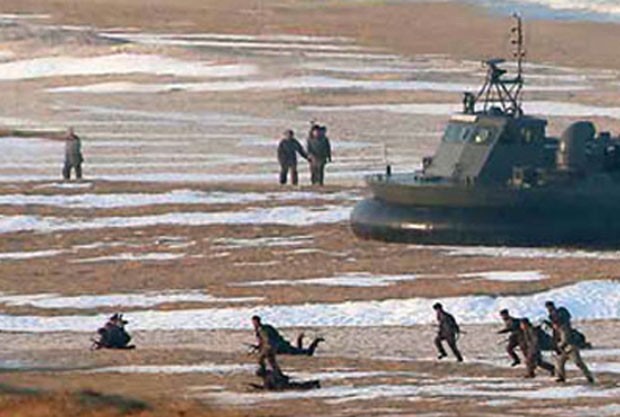 |
| Fig.33 - Troops from North Korean Army disembarking from a hovercraft from Kongbang I class. Navy is a branch from the army so doesn't have marines. |
 |
| Fig. 34- A Kongbang II/III Hovercraft. They are capable of transporting 40 trops, plus the third version is equiped with 57/30mm guns and anti-ship missiles. There are 120 in service in North Korean People's Navy. http://covertshores.blogspot.pt/2010/06/north-korean-semi-submersible-craft.html |
 |
| Fig. 35 - A 57 mm (twin) gun from a Najin Frigate in a real fire exercice. One of the main missions of the Navy in North Korea is give firepower to support the Army |
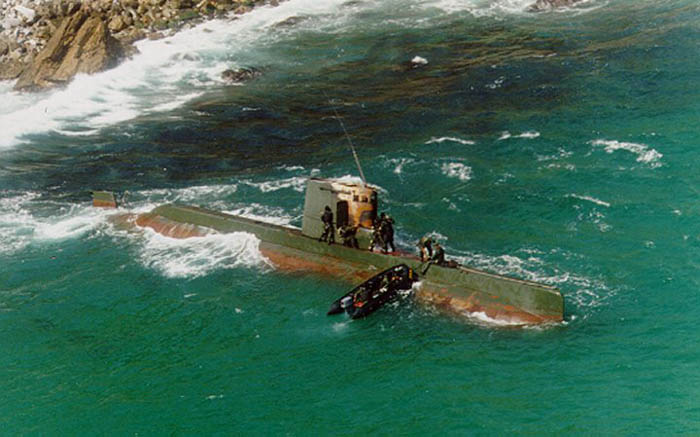 |
| Fig.36 - A Sang -O - I submarine captured by South Korean Navy stranded near the coast line. All the crue was dead in a colective suicide. |
 |
| Fig. 37 - A NKPN Patrol Boat guards the waters off Mount Kumgang, an tourist zone in North Korea. The guns are 25 mm Type 61 chinese guns. The type seems a Shantou class gunboat made in China http://weaponsystems.net/weapon.php?weapon=GG02%20-%20Shantou%20class |
 |
| Fig. 38 - The only Krivak frigate that North Korea have. Current status of ship his unknown and satellite images only show an helicopter deck and hangar. |
 |
| Fig. 39 - A Krivak II class frigate. For years that is like this in North Korea. |
http://news.nationalpost.com/2013/04/10/graphic-north-koreas-conventional-arms/
 |
| Fig.41 - Light Patrol boat in North Korea coast. The gun seams a 25 mm twin. |
https://en.wikipedia.org/wiki/Korean_People%27s_Navy
http://news.usni.org/2014/05/08/two-koreas-three-navies
 |
| Fig.43 - A Type B SILC/RACOON captured by South Korea. Impressd with this infiltration craft the Navy made several for own use. The Racoon also influenced Us forces to use submersible boats. |
http://www.militaryphotos.net/forums/showthread.php?128964-North-Korea-Navy-Photo
 |
| Fig. 44 - DRPK KA35 in action? Seems the Chinese Navy. Russian Foruns... http://www.russiadefence.net/t3535p15-korean-people-s-army-news |
 |
| Fig. 45 - A original Tral Class Corvette. Probably in reserve due to old age the North Korea build a similar class named Sariwon class of four ships. |
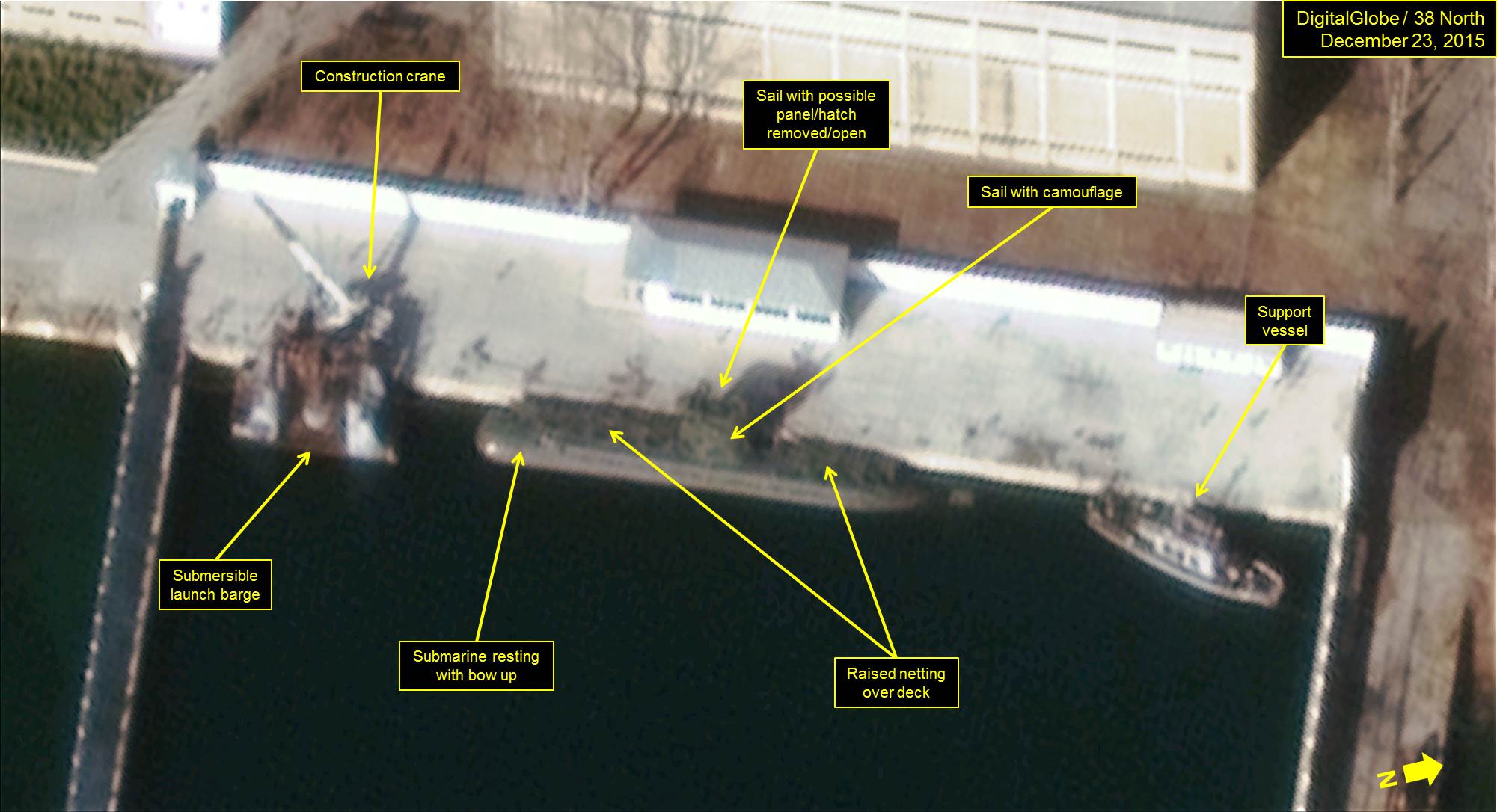 |
| Fig. 46 - Another attempt to a North Korea's Ballistic Missile Submarine? Is this the Simpo Class with to Nk11 Missiles http://www.hisutton.com/images/sinpo_analysis940.jpg |
 |
| Fig.47- The Foxtrot "clone" that is a SLBN test platform for North Korea? The source is Russian, but they have a fine and clear photos of everything above parallel 38. |
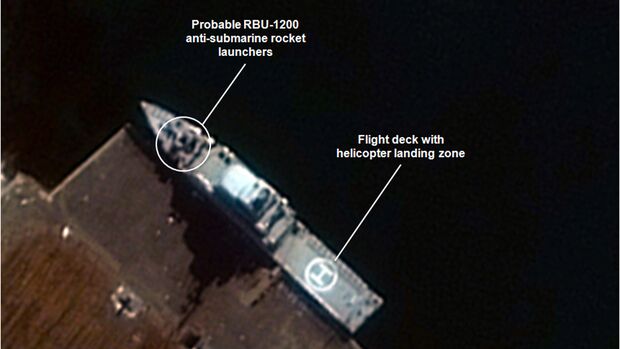 |
| Fig. 48 - Large Helicopter Frigate build in North Korea. Is the Namp'o class. http://www.bloomberg.com/news/articles/2014-05-16/north-korean-navy-builds-two-helicopter-frigates-analyst-says |
 |
| Fig. 49 - North Korea Cargo Ship "Chong Chon Gang" at Air Navy Base Almirante Cristobal in Panama. The ship was released after Panama justice detained in 13 July 2013, with undeclared weapons cargo. |
https://www.tumblr.com/search/north%20korean%20navy
 |
| Fig. 50- Another photo of the Namb'o Class ASW frigates. It seams that has an Hangar and a Helo Pad. Some sources say that have also AA Missiles. http://www.shipbucket.com/forums/viewtopic.php?f=12&t=672 Fig.51 - Also security forces use patrol boats in rivers and near the coast. Most of them are simple wood boats with light guns and with no sensors. Best ships are used by military http://www.bbc.com/travel/story/20140211-peering-into-north-korea Fig. 52 - Another photo of Nambo Naval Base with 3Chaho class Rocket Boats, near a small patrol boat. http://news.nationalpost.com/news/graphics/graphic-north-koreas-conventional-arms Fig.53 - Profile of North Korean People Navy. Nanjim Frigates, Tral/Sariwon Corvettes, Soho ASW frigate, Shershen torpedo boat Komar and Osa missile boat. http://china-defense.blogspot.pt/2014/07/photos-of-day-ciws-of-north-korean-navy.html Fig. 54 - The capture in 1968 of the Spy american Ship USS Pueblo was one of the high moments of NKPN. Today is sized at Taedong River in the capital city in Pyonyang http://www.dailymail.co.uk/news/article-2131197/USS-Pueblo-Aboard-U-S-Navy-ship-captured-40-years-ago-North-Korea.html
Fig. 55 - To "Poder Naval" NKPN, is today more addvanced in SLBN than i think. It checks the testing submarine but theres more two submersible test stand barge. But like we see in this link Kn 11 is still in test. https://missilethreat.csis.org/country/dprk/
http://www.naval.com.br/blog/2017/05/04/coreia-do-norte-avanca-programa-de-misseis-lancados-de-submarino/ |
Subscrever:
Mensagens (Atom)

